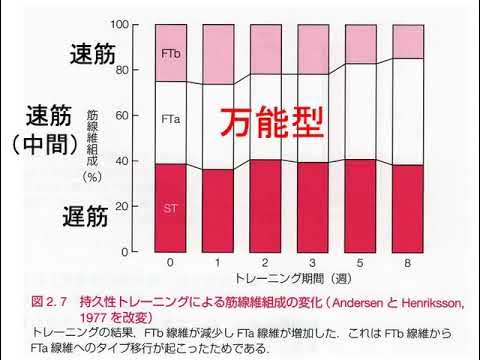Slow Twitch vs. Fast Twitch: Why Muscle Fiber Types Matter
Summary
TLDRThis video explores the different types of skeletal muscle fibers—slow twitch (Type I), fast oxidative (Type IIa), and fast glycolytic (Type IIx)—and their unique characteristics. Slow twitch fibers excel in endurance activities due to their resistance to fatigue, while fast twitch fibers are designed for explosive power but fatigue quickly. The video discusses how genetics influence fiber composition and how consistent training can adapt and even convert these fibers, helping athletes optimize their performance based on their specific training goals.
Takeaways
- 😀 Muscle performance in sports is influenced by muscle fiber types: fast-twitch and slow-twitch.
- 🏃♂️ Slow-twitch fibers (Type I) are suited for endurance activities and resist fatigue.
- ⚡ Fast-twitch fibers (Type II) excel in explosive movements but fatigue quickly.
- 🏋️♀️ Muscle fiber composition is partly genetic, affecting athletic performance.
- 🔄 Training can lead to adaptation and some conversion of muscle fiber types.
- 🏊♀️ Slow oxidative fibers are red, high in mitochondria, and primarily use aerobic metabolism.
- 💪 Fast glycolytic fibers are white, larger, and primarily use anaerobic glycolysis for quick bursts of energy.
- 🟡 Fast oxidative fibers (Type IIa) can use both aerobic and anaerobic pathways, providing versatility.
- 📈 Consistent training can enhance specific fiber types, influencing strength and endurance capabilities.
- 🔬 Research on identical twins shows significant differences in muscle fiber types based on training history.
Q & A
What are the main types of muscle fibers discussed in the transcript?
-The main types of muscle fibers discussed are slow twitch (Type I), fast twitch (Type IIx), and fast oxidative (Type IIa) fibers.
What characteristics define slow twitch muscle fibers?
-Slow twitch fibers, or Type I fibers, are characterized by their slow contraction speed, reliance on aerobic metabolism, high mitochondria and myoglobin content, and excellent endurance.
How do fast twitch fibers differ from slow twitch fibers?
-Fast twitch fibers contract rapidly and rely primarily on anaerobic glycolysis for energy, resulting in quick but less sustainable force. They have a larger diameter and fewer mitochondria, which gives them a pale appearance.
What is the role of fast oxidative fibers?
-Fast oxidative fibers, or Type IIa fibers, act as hybrids, capable of using both aerobic and anaerobic metabolism, providing them with moderate speed, endurance, and resistance to fatigue.
How does training influence muscle fiber composition?
-Training can lead to adaptations in muscle fibers, such as converting some fast twitch fibers to slow twitch with endurance training, or vice versa with high-intensity training.
What is the significance of myoglobin in muscle fibers?
-Myoglobin is a protein that binds and stores oxygen in muscle fibers. Higher myoglobin content in slow twitch fibers contributes to their endurance capabilities, while lower levels in fast twitch fibers affect their fatigue resistance.
What factors determine the proportion of muscle fiber types in an individual?
-Genetics primarily determines the proportion of muscle fiber types in an individual, influencing their natural predisposition towards certain physical activities.
What type of activities are slow twitch fibers best suited for?
-Slow twitch fibers are best suited for endurance activities such as long-distance running, cycling, and swimming due to their high fatigue resistance and aerobic energy production.
Why are fast twitch fibers important for athletes in explosive sports?
-Fast twitch fibers are crucial for explosive sports because they contract rapidly and generate high force, making them ideal for activities requiring short bursts of power, like sprinting and heavy lifting.
What evidence is provided to support the adaptability of muscle fibers?
-The transcript references studies on identical twins, showing that significant differences in muscle fiber composition can occur based on the type of training each twin undertakes over time.
Outlines

此内容仅限付费用户访问。 请升级后访问。
立即升级Mindmap

此内容仅限付费用户访问。 请升级后访问。
立即升级Keywords

此内容仅限付费用户访问。 请升级后访问。
立即升级Highlights

此内容仅限付费用户访问。 请升级后访问。
立即升级Transcripts

此内容仅限付费用户访问。 请升级后访问。
立即升级5.0 / 5 (0 votes)






